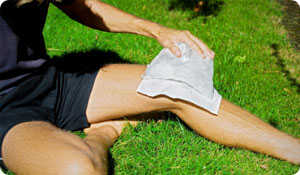
You may not know what Patellofemoral pain syndrome (PFPS) is, but you may have it. PFPS, or "runner's knee," accounts for approximately 42 percent of all overuse injuries. How do you know if you have runner's knee? Simply put, it hurts.
Runner's knee is usually the result of too much exercise on muscles and tendons that may not be as strong as they should be. The American Academy of Orthopedic Surgeons describes runner's knee as, "a dull, aching pain under or around the front of the kneecap (patella) where it connects with the lower end of the thighbone (femur). Pain occurs when walking up or down stairs, kneeling, squatting, and sitting with a bent knee for a long time."
What causes Runner's Knee?
The knee is a complex sensitive structure comprised of the femur, tibia (shin bone), and patella (kneecap) and held in place by several muscles and ligaments. When all pieces fit and work together properly, the knee is one smooth operator. When they don't, ligaments get irritated, muscles get inflamed and bones can rub together and cause pain. When athletes overuse or over train certain muscles, bones can become misaligned (pulled out of proper position).
How is it diagnosed?
Your doctor will do a physical exam and possibly an x-ray, CT scan and/or MRI to rule out other types of structural damage to the knee. He will also ask about recent exercise activities and may have you walk, jump, squat, bend and sit to evaluate your gait, muscle strength and range of motion.
Treatment revolves around common sense advice: Temporarily discontinue activities that caused your knee to hurt and use the RICE formula:
- Rest. Avoid putting weight on the painful knee.
- Ice. Apply cold packs or ice wrapped in a towel for short periods of time, several times a day.
- Compression. Use an elastic bandage such as a knee sleeve with the kneecap cut out that fits snugly without causing pain.
- Elevation. Keep the knee raised above your heart.
Over-the-counter anti-inflammatory and pain medications like ibuprofen are usually adequate for pain. In most cases, runner's knee heals with rest, time and physical therapy or reconditioning exercises. If it doesn't, surgical options include:
Arthroscopy to remove fragments of damaged kneecap cartilage
or
Realignment of the kneecap to reduce pressure on cartilage and supporting structures.
How can you prevent Runner's Knee?
The AAOS offers this advice:
- Stay in shape with good general conditioning.
- Lose Weight if you're too heavy, to avoid overstressing your knees.
- Stretch properly: Before running or any other exercise, start with a 5-minute warm up, followed by stretching exercises. Stretching, particularly in the face down position (prone), helps keep supporting structures around the front of the knee flexible and less likely to be irritated with exercise. Stretch again after exercise.
- Increase training gradually. Avoid sudden changes in the intensity of exercise. Increase force or duration of activities gradually.
- Use proper running gear. Use running shoes with good shock absorption and quality construction. Be sure that shoes fit properly and are in good condition. If you have flat feet, you may need shoe inserts.
- Use proper running form. Lean forward and keep your knees bent.
- Run on clear, smooth, resilient, even, and reasonably soft surfaces. Never run straight down a steep hill. Walk or run in a zigzag pattern.





